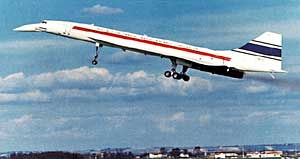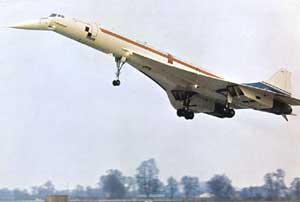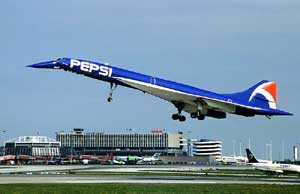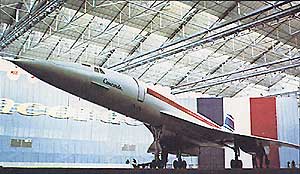| Originally,
the aircraft was called Concord (without an e) in the UK and
Concorde in France. However, after much wrangling, the French spelling
was eventually adopted on both sides of the channel.
The
first prototype was rolled out in Tolouse on 11th December 1967,
but the first test-flight didn't take place until 2nd March 1969. The
flight lasted just 28 minutes, but established that the aircraft flew
perfectly at subsonic speeds.

The maiden flight of Concorde 001, the first prototype
The
first supersonic test flight wasn't until seven months later
on 1st October 1969 when 001 reached Mach 1.05 for a
duration of 9 minutes. Supersonic speeds were ramped up very gradually
in subsequent test-flights, until the first Mach 2 flight on 4th November
1970. A second prototype, 002, was also flown during this time.
The
first pre-production Concorde, originally designated 01 but later
changed to 101 to avoid confusion with 001, was unveiled on 20th September
1971 and first flew on 17th December 1971. This was the first Concorde
flight from the UK. This Concorde can now be viewed
at the Duxford Air Museum.

The maiden flight of Concorde 101, the first pre-production Concorde
BAC
and Aerospatiale were hoping for a great many orders following
a round-the-world sales tour with Concorde 002, but in the end only two
airlines placed orders. British Airways (then known as BOAC) ordered five
and Air France ordered four. The contracts were signed in June and July
1972.
The
first passenger-carrying Concorde flights were on 21st January 1976
when a BA flight to Bahrain and an AF flight to Rio took off simultaneously.
The first transatlantic commercial flights were on 24th May that year.
Those who think they remember an Air Singapore or Braniff Concorde are not imagining things: BA briefly operated a joint venture with both Air Singapore and Braniff, with the Concordes used painted in appropriate livery. However, these were BA Concordes and not additional sales.
Nor are you hallucinating if you remember this advertising stunt for the Pepsi rebranding in 1996 - it was painted that way for two weeks:

Still expecting futher sales, a total of 20 Concordes were built. These were:
- 2 prototypes (001 and 002)
- 2 pre-production aircraft used for further testing, training and sales promotion (101 and 102)
- 2 production-spec Concordes also used for testing & training and which never entered service
- 14 production aircraft intended for sale
Of the 14 Concordes built for sale:
- 5 were sold to BA
- 4 were sold to Air France
This left 5 unsold Concordes. Eventually, realising that no further sales would be forthcoming, the British and French governments sold them to BA (who took 2) and AF (who took 3) for a nominal 1 French Franc each in return for the airlines taking responsibility for the remaining development costs. This gave each airline 7 Concordes (though AF used one of them only for spares pretty much from the outset).
Air France ceased Concorde operations on 31st May 2003. BA ceased Concorde operations on 24th October 2003.
|



